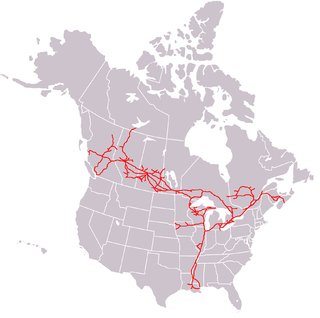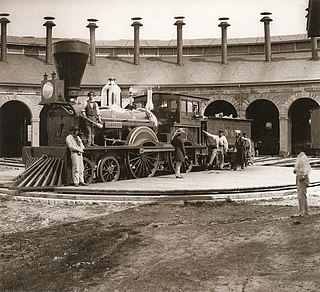
The Canadian National Railway Company is a Canadian Class I freight railway headquartered in Montreal, Quebec, which serves Canada and the Midwestern and Southern United States.

The Grand Trunk Railway was a railway system that operated in the Canadian provinces of Quebec and Ontario and in the American states of Connecticut, Maine, Michigan, Massachusetts, New Hampshire, and Vermont. The railway was operated from headquarters in Montreal, Quebec, with corporate headquarters in London, United Kingdom. It cost an estimated $160 million to build. The Grand Trunk, its subsidiaries, and the Canadian Government Railways were precursors of today's Canadian National Railway.

Beloeil is a city in Quebec, Canada. It is a suburb of Montreal, on the South Shore and is on the Richelieu River, 32 kilometres (20 mi) east of Montreal. According to the official Commission de toponymie du Québec, the name is written Belœil with an oe ligature; however, other sources avoid the ligature, including the Ministry of Municipal Affairs and the town's own official website.

Mont-Saint-Hilaire is a suburb of Montreal on the South Shore of southeastern Quebec, Canada, on the Richelieu River in the Regional County Municipality of La Vallée-du-Richelieu. The population as of the Canada 2011 Census was 18,200. The city is named after the Mont Saint-Hilaire.

The St. Lawrence and Atlantic Railroad, known as St-Laurent et Atlantique Quebec in Canada, is a short-line railway operating between Portland, Maine, on the Atlantic Ocean, and Montreal, Quebec, on the St. Lawrence River. It crosses the Canada–US border at Norton, Vermont, and Stanhope, Quebec, and is owned by short-line operator Genesee & Wyoming.
The Champlain and St. Lawrence Railroad (C&SL) was a historic railway in Lower Canada, the first Canadian public railway and one of the first railways built in British North America.

A moveable bridge, or movable bridge, is a bridge that moves to allow passage for boats or barges. In American English, the term is synonymous with drawbridge, and the latter is the common term, but drawbridge can be limited to the narrower, historical definition used in some other forms of English, in which drawbridge refers to only a specific type of moveable bridge often found in castles.

The Great Western Railway was a railway that operated in Canada West, today's province of Ontario, Canada. It was the first railway chartered in the province, receiving its original charter as the London and Gore Railroad on March 6, 1834, before receiving its final name when it was rechartered in 1845.

The Montreal, Maine and Atlantic Railway was a Class II freight railroad that operated in the U.S. states of Maine and Vermont and the Canadian province of Quebec between 2002 and 2014. It was headquartered in Hermon, Maine.

Mont-Saint-Hilaire is a commuter railway line in Greater Montreal, Quebec, Canada. It is operated by Exo, the operator of public transport services across this region.

Otterburn Park is a small town located 40 kilometres (25 mi) east of Montreal, Quebec, Canada. The population as of the Canada 2011 Census was 8,450. The town lies south of Mont-Saint-Hilaire on the Richelieu River and is one of the few officially bilingual towns in Quebec.

The South Shore is the general term for the suburbs of Montreal, Quebec located on the southern shore of the Saint Lawrence River opposite the Island of Montreal. The South Shore is located within the Quebec administrative region of Montérégie.

The Montreal and Southern Counties Railway Company was an electric interurban streetcar line that served communities between Montreal and Granby from 1909 until 1956. A second branch served the city of Longueuil. Operated by the Canadian National Railway (CN), the M&SCRC ran trams on tracks in the street in Montreal and closer South Shore communities, and on separate right of way in rural areas.

5 ft 6 in / 1,676 mm is a broad track gauge, used in India, Pakistan, western Bangladesh, Sri Lanka, Argentina, Chile, and on BART in the San Francisco Bay Area.














